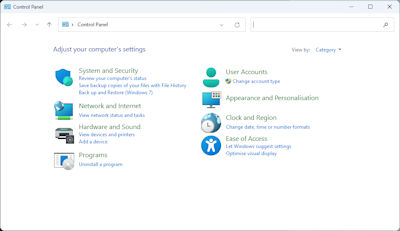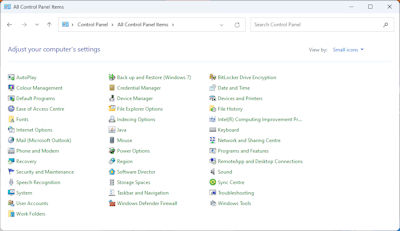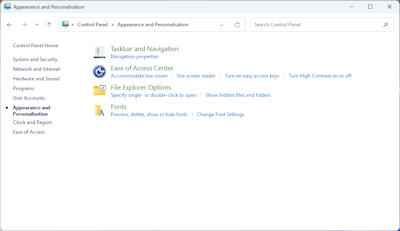
 |
Windows Guide |
In Windows, the Control Panel layout continues to use the control panels in categorised into groups to make it easier to find the control panel to change preferences for windows and include common task links to take you to the correct window such as changing the screen saver. You can switch to Large icons or Small icons to view all control panels if you wish.
The control panel is accessible by opening Explorer, click on This PC, select the Computer tab and select Open Control Panel. Also, you can access it by pressing Windows+X keys and selecting Control Panel, or pressing Windows+R keys and entering Control.exe or it may appear as a tile in the Start screen.


For example, if you wanted to change Appearance and Personalisation you get the following
window with a list of tasks and control panels:
Taskbar and Navigation, Ease of Access Centre, File Explorer Options and Fonts.

Picking a task will load the control panel and switch to the correct tab for you to make the change, or you can select a Control Panel at the bottom such as the Display control panel. Other related panels are listed in the left hand pane.
System and Security
- Security and maintenance, windows defender firewall, system, power options, file history, backup and restore, bitlocker, storage spaces, and windows tools. May also contain other 3rd party control panels.
Network and Internet - Network and sharing center, Internet options.
Hardware and Sound - Devices and printers, autoplay, sound, power options.
Programs - Programs and features, default programs. May also contain the Java control panel.
User Accounts - User accoumts, credential manager. May also contain Mail (32-bit) for Outlook control panel.
Appearance and Personalisation - Personalisation, ease of access center, file explorer options, fonts.
Clock and Region - Date and time, region.
Ease of Access - Ease of access center, speech recognition.
Autoplay - Configure what to do when removable discs are inserted and what programs to run.
Backup and Restore - Create or restore a backup, create a system image, create a repair disk, file history.
Bitlocker Drive Encryption - Enable encryption of disks to protect files and folders from unauthorized persons.
Colour Management - Configure colour profiles for devices such as monitors.
Credential Management - Store usernames and password for access to web sites and network storage.
Date and Time - Configure local date and time settings, additional clocks and internet time.
Default Programs - Configure programs to load for specific file extensions and protocols.
Device Manager - To manage devices and drivers to ensure hardware is working with Windows.
Devices and Printers - To manage peripherals such as scanners, keyboard, mice, network, and printers.
Ease of Access Center - Manage ease of use tools and settings including Magnifier, On-Screen keyboard, Narrator, High Contrast.
File Explorer Options - Configure folder browsing, items, navigation, privacy, views and search options.
File History - Manage copies of files over time to allow restoration of older, damaged or lost files.
Fonts - Add, hide, change or view windows fonts.
Indexing Options -
Enable indexing of files and folders on disk to speed up searches.
Internet Options - Configure settings for Internet Explorer.
Keyboard - Configure repeay delay, repeat rate, cursor blink and driver for keyboard.
Mouse -
Configure buttons, pointer graphics, pointer settings, wheel and hardware drivers.
Network and Sharing Center - Configure Ethernet, Wireless, Blue tooth and network protocols.
Notification Area Icons -
Configure icons in system tray to show, hide and display notifications.
Phone and Modem - Set location, region, dialing rules, area code, modems and telephony options.
Power Options - Set power plans, power buttons, wake up options, sleep options.
Programs and Features - Install, change or remove software and features from windows.
Recovery -
Create a recovery drive, create or do system restores.
Region - Set date and time formats, location, welcome screen settings and languages.
RemoteApp and Desktop Connections - Remote connection settings.
Security and Maintenance - Security for firewall, virus protection, internet, UAC. Maintenance for reporting problems, auto maintenance, file history, drive status, device software. Recovery.
Sound - Configure playback and recording devices, sounds for events, and volume.
Speech Recognition - Setup speech recognition, microphone, tutorial and training.
Storage Spaces - Create a pool and storage space for protection from drive failure (RAID).
Sync Center -
Enable offline files for syncing files with networked storage.
System - Configure computer name, workgroup or domain, remote settings, system restore, performance, environment.
Taskbar and Navigation - Configure the taskbar, navigation areas, jump lists and toolbars.
Troubleshooting - Troubleshoot older programs, hardware and sound, network, internet and security.
User Accounts - Create, modify and delete user accounts, credentials, user profiles and environment variables.
Windows Defender Firewall - Configure network protection against unauthorised access to your system.
Windows Tools -
Various utilities and administrative tools, command prompt and PowerShell.
Work Folders - Configure work folders which make files available across all devices e.g. tablets, smart phones
etc.
Settings
Settings can be accessed via the Gear icon in the start menu, or Settings in the menu program list in the start menu.